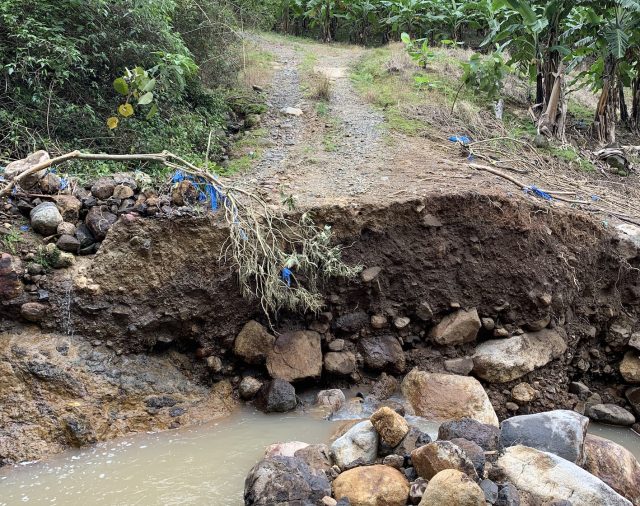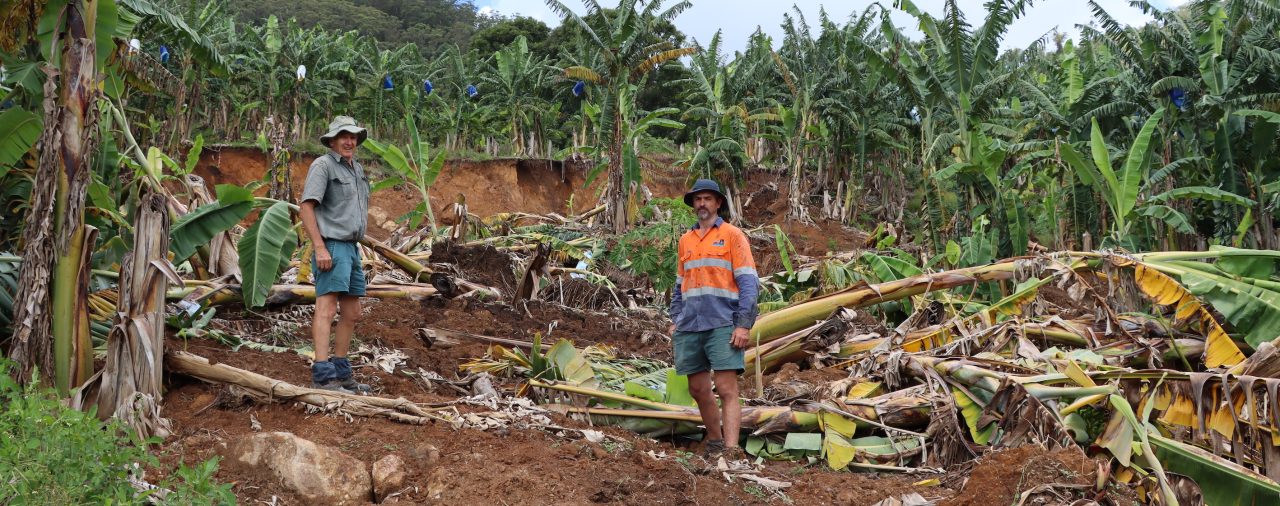
Peter (left) and Dan Molenaar
By Sonia Campbell
Growers in northern New South Wales and the mid-North coast continue to recover from extreme flooding which caused devastation across communities in March.
The catastrophic weather event left a path of destruction, with growers living in and around flood-ravaged areas reporting severe damage to homes, roadways and other infrastructure.
Remarkably though, banana crops were left largely unscathed. However, roadways that were completely washed out in the flash flooding, coupled with continued rainfall in some areas in the week’s following, did impact on a number of growers’ ability to harvest their fruit.
Peter Molenaar, who farms bananas with his son Dan near Mullumbimby – one of the hardest hit areas in the northern region of the state – described the severe weather event as “a disaster like no other, for the Far North Coast of NSW”.
“People are hurting,” he said in the days following. “They are left totally isolated and feel helpless. There is no phone, no power in some instances, no internet and no water at various stages.”
“Mullumbimby has never in recorded history, had a flood enter shops in the CBD, not to mention the countless houses that were inundated. We’ve only ever had floods affect a few houses on the fringes of town. At the farm we had 1040mm in a 30hr period. This was on top of 500mm (over) the previous five days.”
While the extreme rainfall left Peter and Dan unable to access the family farm for a number of days, the pair were thankful not to have suffered major crop losses.
On the farm – which was established by Peter’s father in the early 1950s – large landslips took out a bridge and a culvert, which prevented vehicle access to the farm. While a large landslip also took out some bananas and avocados.
“You can see up in the forest, it’s given way and brought these trees and palms down and they’ve taken out anything in its path. Big rocks have come down and filled up the dam, and kept on going down to the river flats, down to the main road,” Peter said.
“The slip probably consumed about an acre and a half of bananas which were irretrievable. But outside the slip area, we probably lost only about 20 or 30 stools, because there was no wind, which was terrific, because we’ve still got our crop. We’re just so lucky.”
Dan agreed. Speaking on the farm in the week following the event, he said he also expected crop losses to be far worse.
“We’d heard through neighbours in the village that bridges were washed away and what not, and I came out here expecting that all our bananas would be on the ground as well,” Dan recounted. “But I got here and was quietly surprised. Because we didn’t have the wind, we got lucky in that respect. Overall, we could have been a lot worse off.”
Repairing the causeway to allow vehicle access to the farm was expected to take some weeks. In the meantime, Dan has been humping bananas out by foot.
“We’re harvesting into our old landcruiser, driving down to the creek crossing, which is no longer here, and walking the bunches across one by one. So, it’s a pretty long process,” Dan said.
While this process has been very labour intensive, he said, there was simply no other option.
“After you put all the hard work into getting the bunches where they are, you can’t just watch them go ripe or chop them down on the ground. So, if there is a way out, we’ll get them out, simple as that.”
Australian Banana Growers’ Council director Stephen Spear, who farms next to his brother Michael at Taylors Arm in the mid-north coast of NSW also escaped severe crop losses, however lack of access to their farms, left them both unable to harvest their fruit.
Speaking four weeks after the initial flooding event, Stephen said while causeway damage continued to prevent access to his farm, continued rainfall had also left the area so waterlogged, it meant driving machinery or vehicles on the farm was not possible.
“At the moment I still can’t get to my bananas, so I can’t harvest them,” Stephen said.
“It’s just impossible with the causeway damage at the moment, and the road is a steep hill. Even with a tractor, we couldn’t harvest our fruit. That country just hasn’t had a chance to dry out.”
Stephen said his brother Michael had experienced similar frustration, forced to cut down hundreds of bunches in the weeks after the flooding event, because he had no way of getting them to his local ripener.
“I think every banana grower knows what it’s like, when due to inclement weather or low prices you cannot harvest, after all the effort that goes into producing a bunch,” Stephen said.
“Rain events such as we’ve had in the last month, and again this week, you would usually expect a lot of crop damage, but we’ve been very lucky because of the absence of strong winds.”




